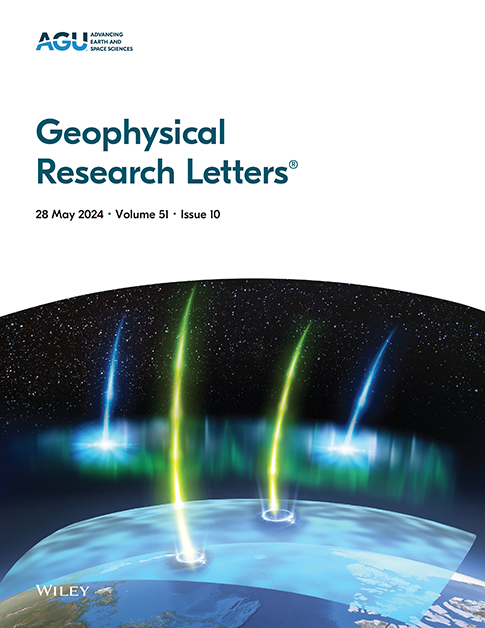Himanshu Saxena, Shreya Mehta, Sipai Nazirahmed, Jitender Kumar, Sanjeev Kumar, Arvind Singh
下载PDF
{"title":"重氮营养体:被忽视的一氧化二氮汇","authors":"Himanshu Saxena, Shreya Mehta, Sipai Nazirahmed, Jitender Kumar, Sanjeev Kumar, Arvind Singh","doi":"10.1029/2024GL114117","DOIUrl":null,"url":null,"abstract":"<p>The ocean is the second-largest source of greenhouse gas nitrous oxide (<span></span><math>\n <semantics>\n <mrow>\n <msub>\n <mi>N</mi>\n <mn>2</mn>\n </msub>\n </mrow>\n <annotation> ${\\mathrm{N}}_{2}$</annotation>\n </semantics></math>O). However, its role as an <span></span><math>\n <semantics>\n <mrow>\n <msub>\n <mi>N</mi>\n <mn>2</mn>\n </msub>\n </mrow>\n <annotation> ${\\mathrm{N}}_{2}$</annotation>\n </semantics></math>O sink is severely overlooked. <span></span><math>\n <semantics>\n <mrow>\n <msub>\n <mi>N</mi>\n <mn>2</mn>\n </msub>\n </mrow>\n <annotation> ${\\mathrm{N}}_{2}$</annotation>\n </semantics></math>O fixation by diazotrophs has lately been proposed as a new pathway of <span></span><math>\n <semantics>\n <mrow>\n <msub>\n <mi>N</mi>\n <mn>2</mn>\n </msub>\n </mrow>\n <annotation> ${\\mathrm{N}}_{2}$</annotation>\n </semantics></math>O consumption. We investigated diazotrophic <span></span><math>\n <semantics>\n <mrow>\n <msub>\n <mi>N</mi>\n <mn>2</mn>\n </msub>\n </mrow>\n <annotation> ${\\mathrm{N}}_{2}$</annotation>\n </semantics></math>O consumption and examined the anthropogenic influence on <span></span><math>\n <semantics>\n <mrow>\n <msub>\n <mi>N</mi>\n <mn>2</mn>\n </msub>\n </mrow>\n <annotation> ${\\mathrm{N}}_{2}$</annotation>\n </semantics></math>O dynamics in the coastal northeastern Arabian Sea, a hotspot of <span></span><math>\n <semantics>\n <mrow>\n <msub>\n <mi>N</mi>\n <mn>2</mn>\n </msub>\n </mrow>\n <annotation> ${\\mathrm{N}}_{2}$</annotation>\n </semantics></math>O emissions. Our findings reveal that relatively unperturbed waters, unlike anthropogenically perturbed waters, are a modest net <span></span><math>\n <semantics>\n <mrow>\n <msub>\n <mi>N</mi>\n <mn>2</mn>\n </msub>\n </mrow>\n <annotation> ${\\mathrm{N}}_{2}$</annotation>\n </semantics></math>O sink (98 <span></span><math>\n <semantics>\n <mrow>\n <mo>±</mo>\n </mrow>\n <annotation> $\\pm $</annotation>\n </semantics></math> 29<span></span><math>\n <semantics>\n <mrow>\n <mi>%</mi>\n </mrow>\n <annotation> $\\%$</annotation>\n </semantics></math> saturation), contrary to previous reports. <span></span><math>\n <semantics>\n <mrow>\n <msub>\n <mi>N</mi>\n <mn>2</mn>\n </msub>\n </mrow>\n <annotation> ${\\mathrm{N}}_{2}$</annotation>\n </semantics></math>O fixation remains active in anthropogenically perturbed waters in contrast to <span></span><math>\n <semantics>\n <mrow>\n <msub>\n <mi>N</mi>\n <mn>2</mn>\n </msub>\n </mrow>\n <annotation> ${\\mathrm{N}}_{2}$</annotation>\n </semantics></math> fixation. We additionally provide evidence that the absence of control incubations leads to incorrect fixation rate estimates, further implying that oceanic dark carbon fixation rates might be overestimated. We suggest that <span></span><math>\n <semantics>\n <mrow>\n <msub>\n <mi>N</mi>\n <mn>2</mn>\n </msub>\n </mrow>\n <annotation> ${\\mathrm{N}}_{2}$</annotation>\n </semantics></math>O fixation not only directly sequesters <span></span><math>\n <semantics>\n <mrow>\n <msub>\n <mi>N</mi>\n <mn>2</mn>\n </msub>\n </mrow>\n <annotation> ${\\mathrm{N}}_{2}$</annotation>\n </semantics></math>O but may correspond to 0.3 Tg C <span></span><math>\n <semantics>\n <mrow>\n <msup>\n <mi>y</mi>\n <mrow>\n <mo>−</mo>\n <mn>1</mn>\n </mrow>\n </msup>\n </mrow>\n <annotation> ${\\mathrm{y}}^{-1}$</annotation>\n </semantics></math> of global ocean net primary production.</p>","PeriodicalId":12523,"journal":{"name":"Geophysical Research Letters","volume":"52 6","pages":""},"PeriodicalIF":4.6000,"publicationDate":"2025-03-18","publicationTypes":"Journal Article","fieldsOfStudy":null,"isOpenAccess":false,"openAccessPdf":"https://onlinelibrary.wiley.com/doi/epdf/10.1029/2024GL114117","citationCount":"0","resultStr":"{\"title\":\"Diazotrophs: An Overlooked Sink of N2O\",\"authors\":\"Himanshu Saxena, Shreya Mehta, Sipai Nazirahmed, Jitender Kumar, Sanjeev Kumar, Arvind Singh\",\"doi\":\"10.1029/2024GL114117\",\"DOIUrl\":null,\"url\":null,\"abstract\":\"<p>The ocean is the second-largest source of greenhouse gas nitrous oxide (<span></span><math>\\n <semantics>\\n <mrow>\\n <msub>\\n <mi>N</mi>\\n <mn>2</mn>\\n </msub>\\n </mrow>\\n <annotation> ${\\\\mathrm{N}}_{2}$</annotation>\\n </semantics></math>O). However, its role as an <span></span><math>\\n <semantics>\\n <mrow>\\n <msub>\\n <mi>N</mi>\\n <mn>2</mn>\\n </msub>\\n </mrow>\\n <annotation> ${\\\\mathrm{N}}_{2}$</annotation>\\n </semantics></math>O sink is severely overlooked. <span></span><math>\\n <semantics>\\n <mrow>\\n <msub>\\n <mi>N</mi>\\n <mn>2</mn>\\n </msub>\\n </mrow>\\n <annotation> ${\\\\mathrm{N}}_{2}$</annotation>\\n </semantics></math>O fixation by diazotrophs has lately been proposed as a new pathway of <span></span><math>\\n <semantics>\\n <mrow>\\n <msub>\\n <mi>N</mi>\\n <mn>2</mn>\\n </msub>\\n </mrow>\\n <annotation> ${\\\\mathrm{N}}_{2}$</annotation>\\n </semantics></math>O consumption. We investigated diazotrophic <span></span><math>\\n <semantics>\\n <mrow>\\n <msub>\\n <mi>N</mi>\\n <mn>2</mn>\\n </msub>\\n </mrow>\\n <annotation> ${\\\\mathrm{N}}_{2}$</annotation>\\n </semantics></math>O consumption and examined the anthropogenic influence on <span></span><math>\\n <semantics>\\n <mrow>\\n <msub>\\n <mi>N</mi>\\n <mn>2</mn>\\n </msub>\\n </mrow>\\n <annotation> ${\\\\mathrm{N}}_{2}$</annotation>\\n </semantics></math>O dynamics in the coastal northeastern Arabian Sea, a hotspot of <span></span><math>\\n <semantics>\\n <mrow>\\n <msub>\\n <mi>N</mi>\\n <mn>2</mn>\\n </msub>\\n </mrow>\\n <annotation> ${\\\\mathrm{N}}_{2}$</annotation>\\n </semantics></math>O emissions. Our findings reveal that relatively unperturbed waters, unlike anthropogenically perturbed waters, are a modest net <span></span><math>\\n <semantics>\\n <mrow>\\n <msub>\\n <mi>N</mi>\\n <mn>2</mn>\\n </msub>\\n </mrow>\\n <annotation> ${\\\\mathrm{N}}_{2}$</annotation>\\n </semantics></math>O sink (98 <span></span><math>\\n <semantics>\\n <mrow>\\n <mo>±</mo>\\n </mrow>\\n <annotation> $\\\\pm $</annotation>\\n </semantics></math> 29<span></span><math>\\n <semantics>\\n <mrow>\\n <mi>%</mi>\\n </mrow>\\n <annotation> $\\\\%$</annotation>\\n </semantics></math> saturation), contrary to previous reports. <span></span><math>\\n <semantics>\\n <mrow>\\n <msub>\\n <mi>N</mi>\\n <mn>2</mn>\\n </msub>\\n </mrow>\\n <annotation> ${\\\\mathrm{N}}_{2}$</annotation>\\n </semantics></math>O fixation remains active in anthropogenically perturbed waters in contrast to <span></span><math>\\n <semantics>\\n <mrow>\\n <msub>\\n <mi>N</mi>\\n <mn>2</mn>\\n </msub>\\n </mrow>\\n <annotation> ${\\\\mathrm{N}}_{2}$</annotation>\\n </semantics></math> fixation. We additionally provide evidence that the absence of control incubations leads to incorrect fixation rate estimates, further implying that oceanic dark carbon fixation rates might be overestimated. We suggest that <span></span><math>\\n <semantics>\\n <mrow>\\n <msub>\\n <mi>N</mi>\\n <mn>2</mn>\\n </msub>\\n </mrow>\\n <annotation> ${\\\\mathrm{N}}_{2}$</annotation>\\n </semantics></math>O fixation not only directly sequesters <span></span><math>\\n <semantics>\\n <mrow>\\n <msub>\\n <mi>N</mi>\\n <mn>2</mn>\\n </msub>\\n </mrow>\\n <annotation> ${\\\\mathrm{N}}_{2}$</annotation>\\n </semantics></math>O but may correspond to 0.3 Tg C <span></span><math>\\n <semantics>\\n <mrow>\\n <msup>\\n <mi>y</mi>\\n <mrow>\\n <mo>−</mo>\\n <mn>1</mn>\\n </mrow>\\n </msup>\\n </mrow>\\n <annotation> ${\\\\mathrm{y}}^{-1}$</annotation>\\n </semantics></math> of global ocean net primary production.</p>\",\"PeriodicalId\":12523,\"journal\":{\"name\":\"Geophysical Research Letters\",\"volume\":\"52 6\",\"pages\":\"\"},\"PeriodicalIF\":4.6000,\"publicationDate\":\"2025-03-18\",\"publicationTypes\":\"Journal Article\",\"fieldsOfStudy\":null,\"isOpenAccess\":false,\"openAccessPdf\":\"https://onlinelibrary.wiley.com/doi/epdf/10.1029/2024GL114117\",\"citationCount\":\"0\",\"resultStr\":null,\"platform\":\"Semanticscholar\",\"paperid\":null,\"PeriodicalName\":\"Geophysical Research Letters\",\"FirstCategoryId\":\"89\",\"ListUrlMain\":\"https://onlinelibrary.wiley.com/doi/10.1029/2024GL114117\",\"RegionNum\":1,\"RegionCategory\":\"地球科学\",\"ArticlePicture\":[],\"TitleCN\":null,\"AbstractTextCN\":null,\"PMCID\":null,\"EPubDate\":\"\",\"PubModel\":\"\",\"JCR\":\"Q1\",\"JCRName\":\"GEOSCIENCES, MULTIDISCIPLINARY\",\"Score\":null,\"Total\":0}","platform":"Semanticscholar","paperid":null,"PeriodicalName":"Geophysical Research Letters","FirstCategoryId":"89","ListUrlMain":"https://onlinelibrary.wiley.com/doi/10.1029/2024GL114117","RegionNum":1,"RegionCategory":"地球科学","ArticlePicture":[],"TitleCN":null,"AbstractTextCN":null,"PMCID":null,"EPubDate":"","PubModel":"","JCR":"Q1","JCRName":"GEOSCIENCES, MULTIDISCIPLINARY","Score":null,"Total":0}
引用次数: 0
引用
批量引用


 求助内容:
求助内容: 应助结果提醒方式:
应助结果提醒方式:


